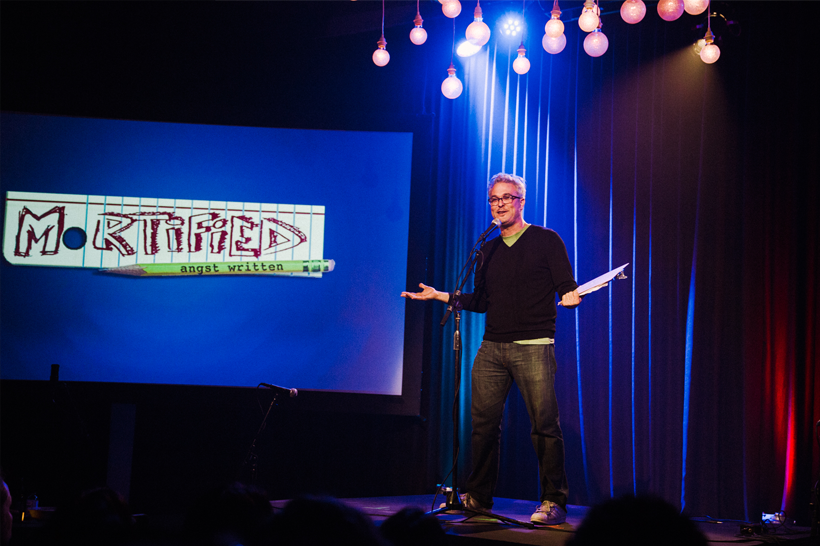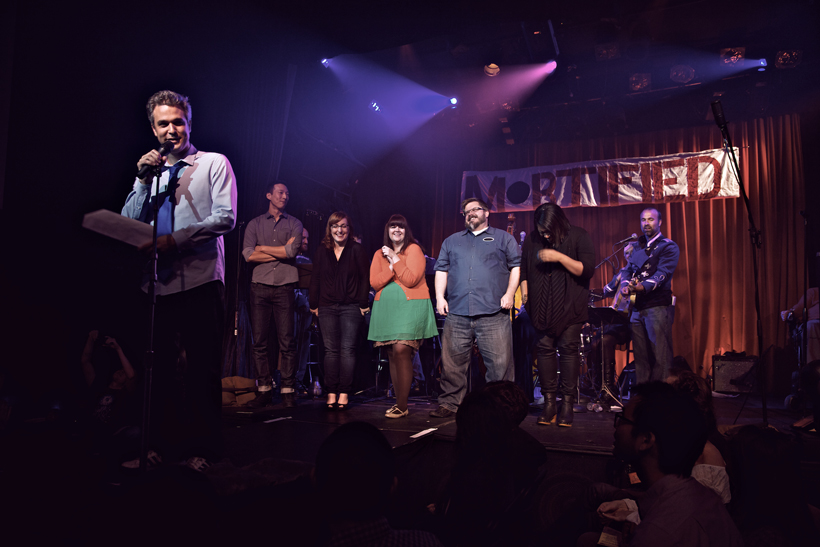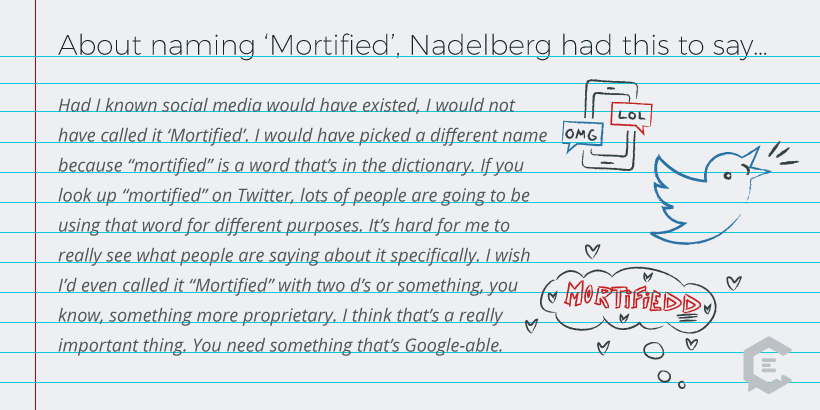David Nadelberg, founder of ‘Mortified’, says, “The thing I always say is and it sounds really simple: If you want someone to talk about something, give them something to talk about.” The same goes for your content marketing. If it isn’t generating engagement and conversation, you may need to revisit your strategy.

You know the story: Writer has good idea. Writer scribbles idea into fancy $10 “idea book.” Writer floats idea past friend. Doesn’t get response. Forgets idea ever existed. Moves on with disgruntled life. For probably 99-percent of writers, that story may resonate with remorse-fueled accuracy. For every potentially culture-bending idea ever hatched, most end up wasted away in the so-called circular file. It’s just a universal human truth that most writers live with — and some die with.
Not for David Nadelberg, founder of ‘Mortified,’ whose idea inspired by an unsent love letter (excerpted below) eventually blossomed into what Newsweek called “a cultural phenomenon,” getting covered by NPR’s ‘This American Life’, ‘The Today Show’ and Entertainment Weekly. Soon thereafter, it went global with ongoing live events happening in over 20 cities worldwide.
The idea behind ‘Mortified’? To have adults share “embarrassing things they created as kids — diaries, letters, lyrics and beyond — in front of total strangers.” If you’ve never seen a show (or revisited any of your own pre-pubescent scribblings), you quickly realize these stories to be accidentally funny years later. They include everything from awkward teen hookups to cringeworthy coming-of-age moments filtered through the lens of often-ineloquent teenagers. It started one night in 2003 as a live stage show in Los Angeles with fully formed grownups reading their overly dramatic diary entries.
Since then, it’s morphed into three books, a documentary, a TV show on Sundance Channel and now another premiering on Amazon and Netflix (February 1st and 14th respectively). It’s also become a popular podcast series produced in partnership with PRX (Public Radio Exchange) and Radiotopia.
On a frigid 70-degree winter day in L.A. (sarcasm invoked), I sat down with Nadelberg over kale salad just steps from the La Brea Tar Pits, where dinosaurs — like most teen diaries — were once safely tucked away on our planet, but have now been extracted for millions to gawk at and revel in. We chatted about the success of ‘Mortified’, what makes big ideas resonate in this day and age, and how he nurtured the seed of an idea that could’ve easily ended up on the writer’s version of the cutting room floor.
Q&A With ‘Mortified’ Creator David Nadelberg
Thanks for taking some time out to chat about America’s teen girl diaries – and boys too.
Yes. I’m the teenage expert… accidentally.
Tell us how you hatched the idea for ‘Mortified’.
‘Mortified’ began when I found a love letter in my twenties that I wrote when I was a teenager to a girl that I had a crush on. I thought, “Thank God I never delivered this. An idiot wrote this.” And this kid is me. I recognized a lot of similarities between the kid who wrote this and who I’d grown up to be. I also recognized that there were a lot of differences. I thought: There’s something interesting in that relationship between our past and present self.

How did you water this seed of inspiration?
I started reading the letter to some friends… they all laughed. It was probably around 2000 when I found it, but it kind of sat around in my brain for a while. Actually my first thought was to do a show called ‘Crush Night’, where people read unsent love letters from childhood, from adolescents. Eventually I pitched it to my friend and he actually didn’t respond and I was so devastated by his lack of response that I kind of put it away in a drawer for years.
Then what happened?
One day I was talking to somebody about their diary, a co-worker named Jen and she said, “Oh my god, when I found my diary I was so mortified!” A light bulb went off and I was like, that’s the project I’ve been noodling with in my head for a year or two! I should make it more expansive, more inclusive to feature diaries and poems and not just love letters… that’s too specific.
Also, I think I should call it… “Mortified.”
What was the next step that made Mortified something real?
Failure. I was an aspiring TV writer and actually sold a bunch of pilots at once and they actually got shot. It was like, “Oh my God, what’s happening in my life? This is going to be the future. I’ve made it. I’m in my mid-twenties and I made it and oh my God, it was really exciting.“ Then they all died – because that’s what happens to pilots.
Hollywood reality check?
Yeah. What I’ve since learned is that nobody knows anything. Experience means a lot, but every project is different and therefore they [the networks] don’t have any more experience on your project necessarily than you do. In fact, you probably understand your project better than they do. In the case of something weird like Mortified, which is not a cop show, not a sitcom set in a coffee shop with a bunch of friends… it doesn’t fit into a box neatly like that. As a result, it needed to be nurtured. From very early on, I realized I needed to go outside the system if I ever wanted to have success with it, whether on stage, on screen or in books or beyond.
How did that first Mortified event go down?
I rented a theater on Melrose I think for like 350 bucks. It was a theater that was no longer there, loosely affiliated with the Second City. And then after that show, I wanted to do another one. I thought it would take me three weeks, but it took me months and months and months. All because I realized I had to learn some sort of curating process – what makes this stuff good.
I needed to find a way for this to be fun for the audience versus just therapeutic for the storyteller.
When did you realize you had a success on your hands?
Depends on how you define success. If you define success by this is bigger than what I thought, I would literally say it was the first night. People were asking me when’s the next one. This was intended as a one-night experiment to put some happiness in my life because of some failures, a lark and people wanted to know, “When’s the next one?” I hadn’t really thought about that too much.
It just sort of snowballed from there.
Now this little thing you created has made it across the world with stage shows in London, Oslo, Norway and a bunch of other cities…
It’s crazy. All from a love letter to a girl who has no idea it’s something she inspired…

What do you think caught on about ‘Mortified’, that people loved?
I think there’s a real hunger in audiences for things that are screamingly real, but also entertaining. There’s nothing inherently funny about a mirror to reality. Just because it’s real doesn’t make it interesting, but there’s something about what ‘Mortified’ gets to spotlight, diaries and other childhood writings from these teenagers from decades before… that winds up feeding a hunger they have for things that are more real, more authentic.
What’s the marketing success story for ‘Mortified’? Is it word of mouth or did you devise a strategy for how to promote things socially?
All the success of ‘Mortified’ has been word of mouth, 90 percent. Nowadays we do pay for Facebook posts… because you have to, but that makes up for very little of how people are aware of ‘Mortified’. When I do Facebook ads, I am only promoting to the people who are already ‘Mortified’ fans on Facebook. So I’m not getting new people with that. The way we get new people is that somebody’s at a party and they go, “I just found my teenage diary” and the other person says, “Oh, you should do that show”… “What show?”… “Oh, it’s this thing called like Terrified or something.”… “Oh wait. It’s called Mortified, right?”… “I think I heard about that on NPR.” It becomes this whole dialogue.
The thing I always say is and it sounds really simple: If you want someone to talk about something, give them something to talk about. That’s the dumbest, most obvious thing in the world, and I can’t tell you how many people don’t understand that. Like literally, marketers don’t understand that when you’re selling product… why should I talk about it?
At this stage, ‘Mortified’ has made its way across most well-known publishing mediums including over 100+ podcasts so far. What has the podcast done for the ‘Mortified’ brand so far?
The podcast has given ‘Mortified’ a consistent platform that extends beyond the stage. We had done books in the past, some film and TV projects, but nothing that really captured the stage show on an ongoing basis. The podcast became the first way we could have a consistent adaptation of our stage show. Weirdly, it promotes the stage show, but also the stage show feeds the podcast. And so it’s this lovely ecosystem where they’re both feeding each other; promoting each other; supplying each other with content.
Can you give an example of that?
Someone hears the podcast content and says, “Oh, I want to attend that show. Or even better, they go, Oh my God, I want to be in that show… Oh Wow. There’s a chapter right here in my local city. I have some diaries. I wonder if they are any good or I wonder if they’re right for Mortified.”
I try to avoid language like, “Is it good or not?’” Because you never wrote your diary to be funny for ‘Mortified’. We’re never judging you on: Are you good or are you bad? Are you talented or not talented? Because it’s not a talent contest. It just happens to be that we have weird criteria of: What did you create that is accidentally funny?
Was launching the podcast easy?
We – and by we, I mean Neil Katcher who runs Mortified with me – spent a long time doing various pilots for the podcast prior to working with Radiotopia. And then once we joined Radiotopia, our podcast network, we made even more and really kept experimenting, experimenting. Then probably over the course of the first 30 shows, we were just playing and then about 30 shows in, it really started to kind of evolve a bit more. We started taking more chances and all that kind of stuff.
What did you learn at episode 30 that you wished you knew at episode 1?
Well, in the first few episodes, we did audio interviews using Google Voice and learned that our audience will have a larger amount of patience to listen to audio… the clearer the audio is. So let’s say you record an interesting conversation with somebody with crappy audio. Maybe the audience wants to hear it for one minute, at most. With decent audio, the audience might be able to tolerate it for four minutes. But with amazing audio, they could probably listen to it for like a half hour if it was compelling.
And so the audio quality impacts patience in the audience.
Have celebrity guests given a boost to the Mortified brand?
I’m not a huge believer in the power of celebrity. I think it’s often an overstated thing. We had a TV talk show a couple years ago that involved celebrities and I don’t necessarily think it got us any more or less press because of that. I think there are tons of TV series that come out every year starring huge name people, huge A-list movie actors and nobody’s aware of them. And so it’s not the magic formula that everyone seems to think…though, it can be effective at times. One thing that celebrities can do, as we will occasionally have celebrities involved in the stage show or the podcast or whatever… is legitimize you where it makes you seem like more of an official thing for some reason. You’re more part of the culture, I guess.
Are there any celebrities you had to turn down because their stories weren’t embarrassing enough?
Yes.
Our audience doesn’t care that you’re funny. How talented you are as an adult has no bearing on how enjoyable you will be in Mortified. At the end of the day, it’s about: Did you write something that was accidentally hilarious when you were a kid? We’ve had comedians on our show who were very funny — who are mediocre on ‘Mortified’. We’ve also had comedians in Mortified who are not that funny on stage, but are hilarious on Mortified. And we’ve had people who were lawyers and architects, and soccer moms and history teachers who are in theory, not very funny people, and they’re amazing on Mortified.
The audience treats it like an egalitarian thing. It’s just like make me laugh and I’ll enjoy it.
I saw that you are personally doing storytelling workshops for companies. Tell us about that.
I run these storytelling workshops where I visit an organization and show their team What is storytelling… and ‘Mortified’s approach to storytelling. Not because I think that they’ll benefit from knowing about Mortified, but because I think there are tools we use to tell stories that are applicable to anything in life. A lot has been made about how storytelling is important especially in advertising — everything is narrative. Some of it is a good old-fashioned hooey, if I can sound grandfatherly enough with my dismissal…
Thanks for keeping it tame.
…But a lot of it is true and not just buzzword fixation. Storytelling is important. Everything in life, from how you date to how you buy a car, to everything in your job… story drives a lot of it. Story is just a way of organizing information in a way that your audience is hardwired to care about. It’s just literally stories just about organizing information in a specific way. What Mortified is good at is taking things that were never intended to be stories in the first place. Diaries, poems, love letters, rap lyrics you wrote when you were 13… and mining those for narrative. That concept of extracting is a tool that I like to teach people because if you are an educator, you’re trying to teach people a set of information. If you’re a researcher, you’re trying to share data and if you’re an advertiser, you’re trying communicate why a brand is of value. The Mortified Method, which is what I teach in the storytelling workshops can help people mine anything for story… We use a very fun tool, which is your childhood memories. So I ask people about their first kiss or your yearbook photo from Instagram and I’ll show you how we can turn that into a story.
Who’s benefitted from The Mortified Method so far?
We’ve done it for Eventbrite and Cartoon Network… and I did it recently at a Museum of Contemporary Art in St Louis. Honestly, one of my biggest thrills is getting to do that. I like teaching a lot. I want to do more of it.
So, what’s next for ‘Mortified’?
We just released a new book that’s actually a diary. Our past books were all anthologies and this book is an interactive book full of provocative questions to help you reflect on your life called My Mortified Life. It’s a really fun take on the brand with questions so you can write about your own awkward adolescence. Great for if you never kept a teenage diary, now’s your chance… belated.
Then, on February 1st on Amazon and Valentine’s Day on Netflix, we’re launching a new series called ‘The Mortified Guide‘, which just premiered at the Sundance Film Festival. It’s an exciting series, six episodes. Each one’s an hour. Each one tackles a theme like romance or family or pop culture or sexual orientation… and explores that theme through different kids’ experiences growing up.
Here’s a peek:





